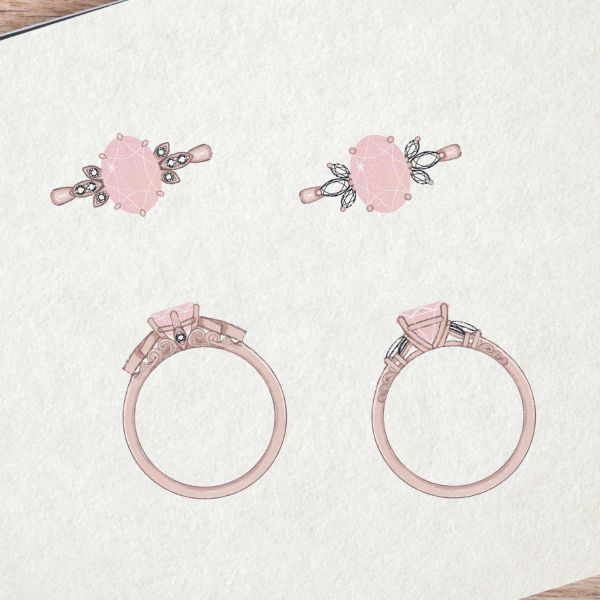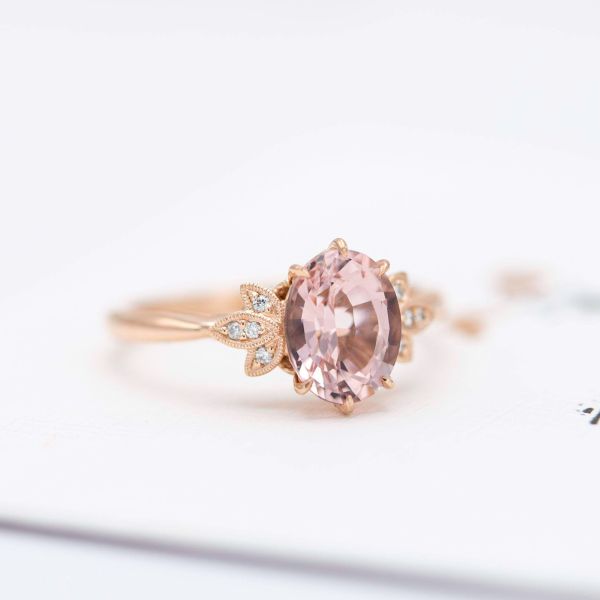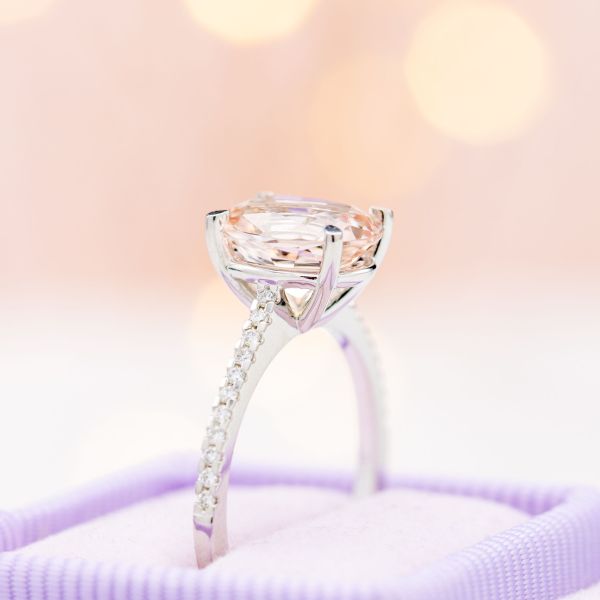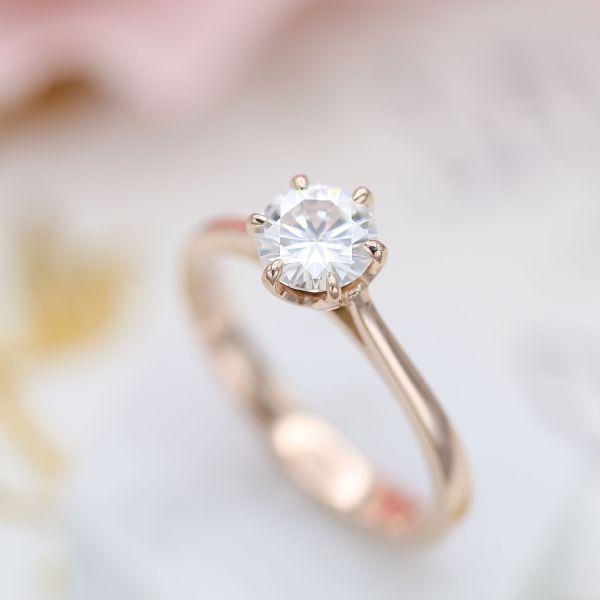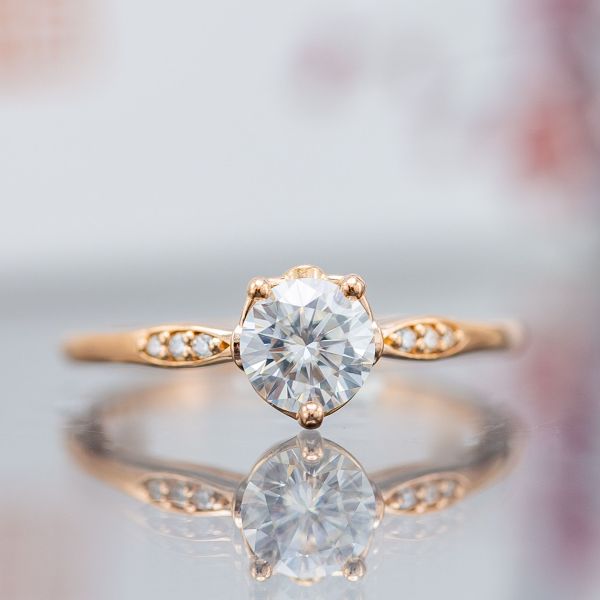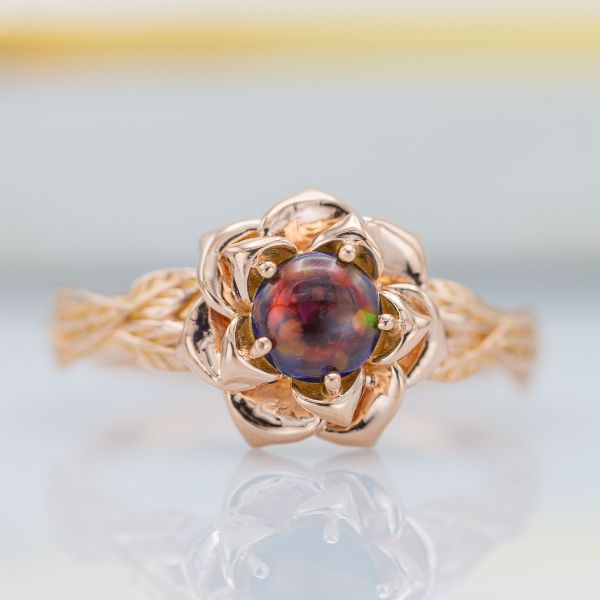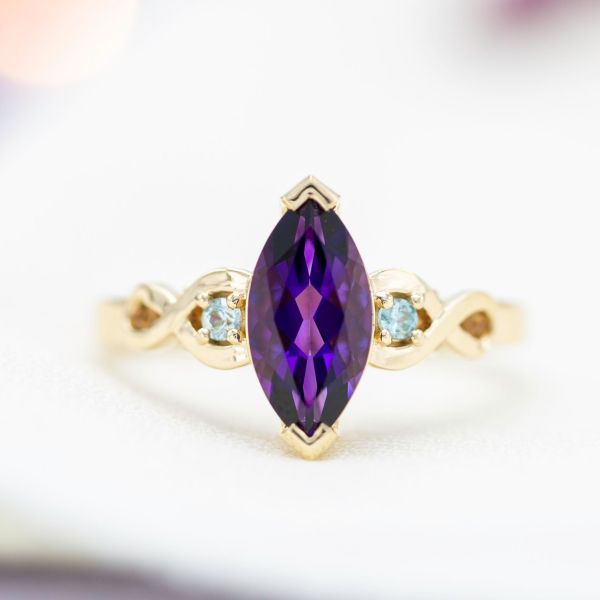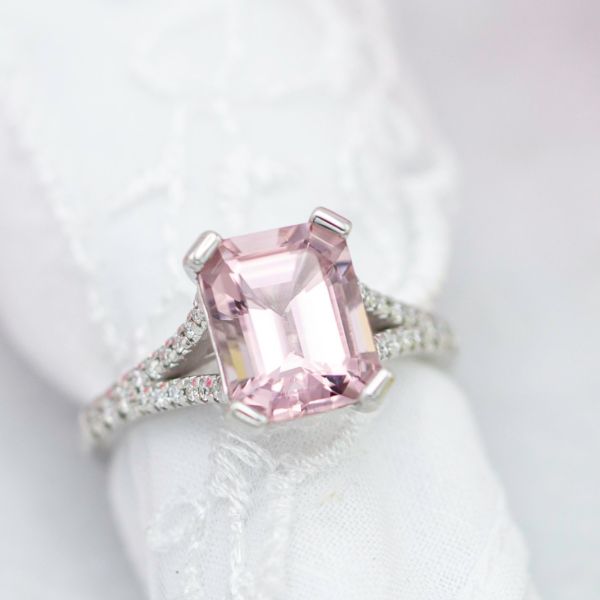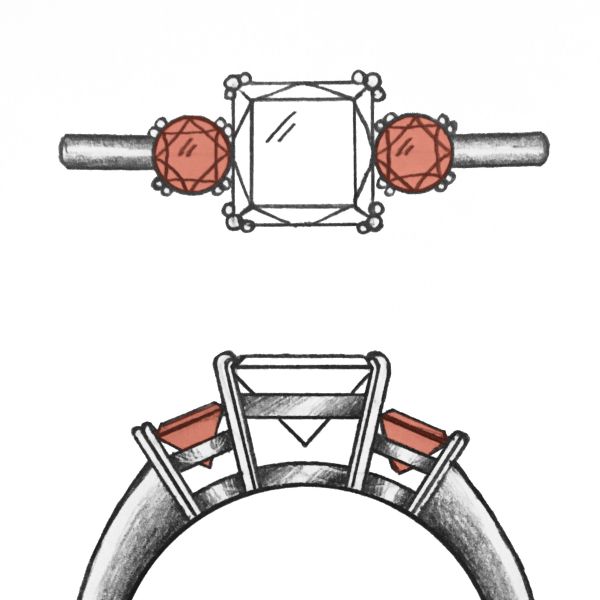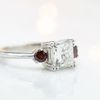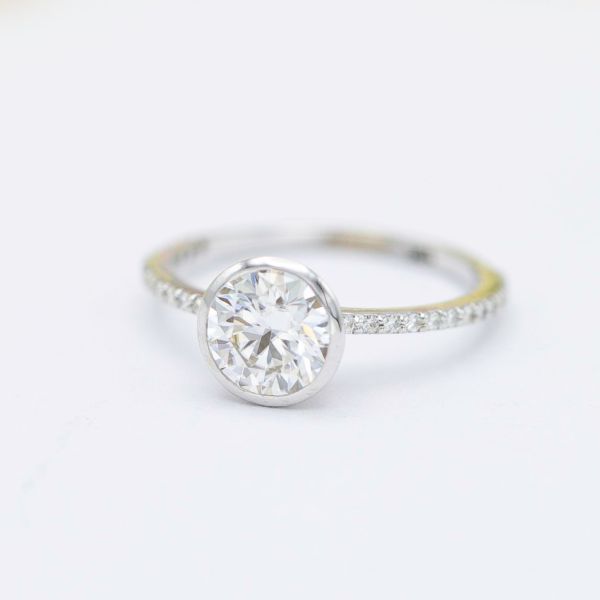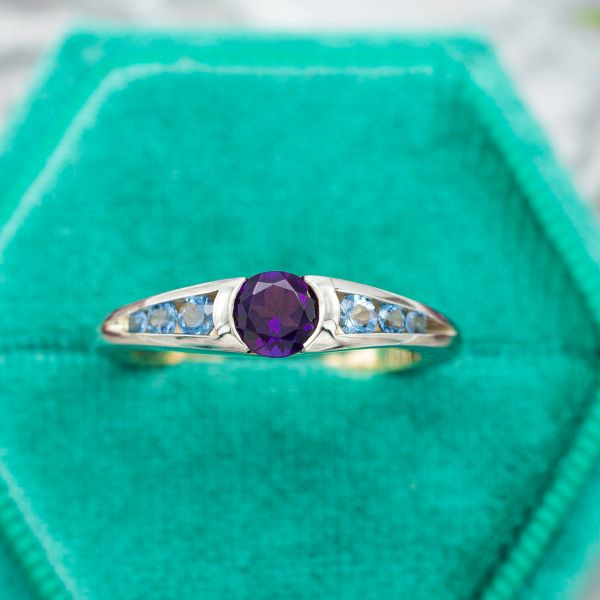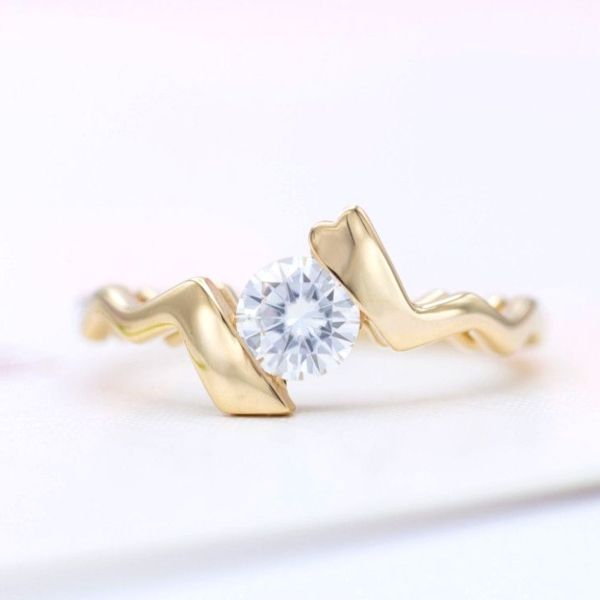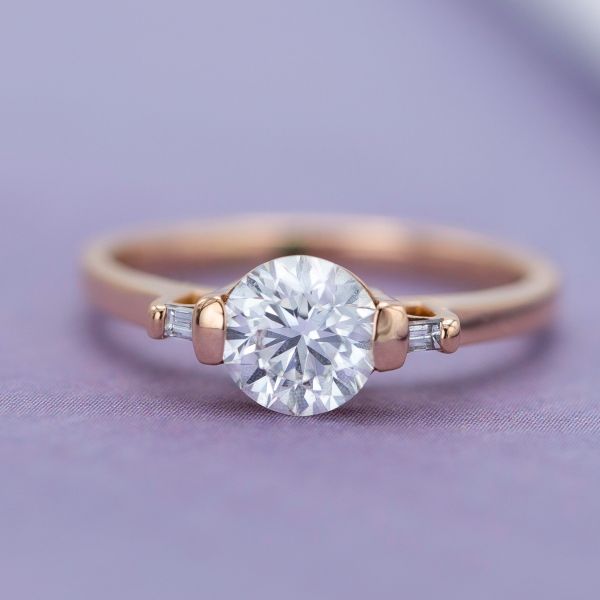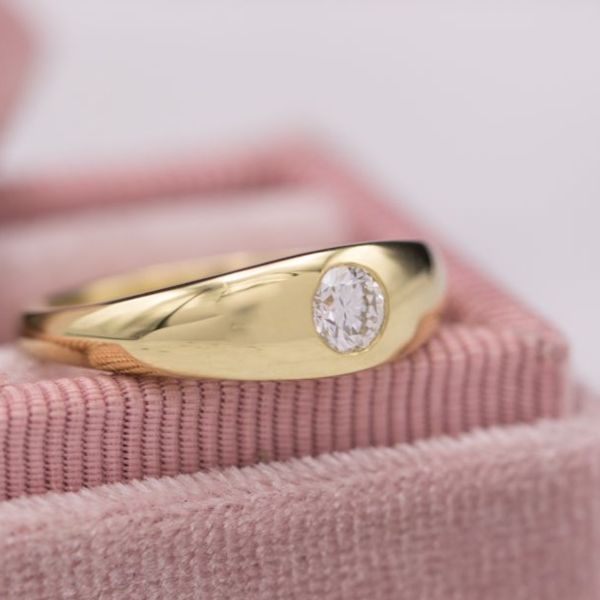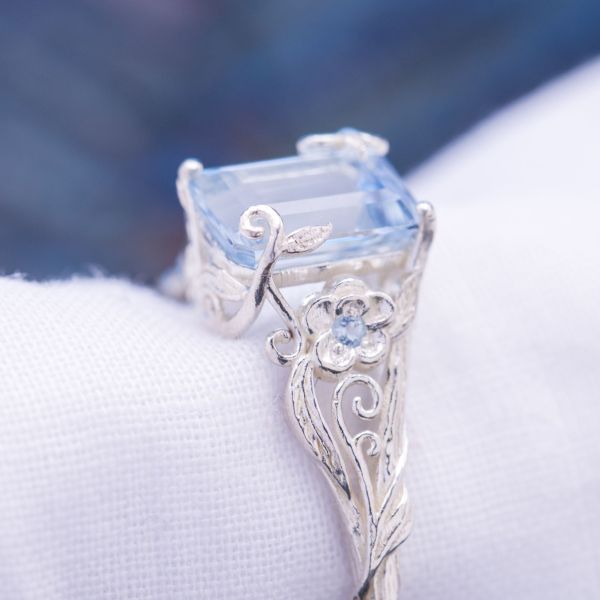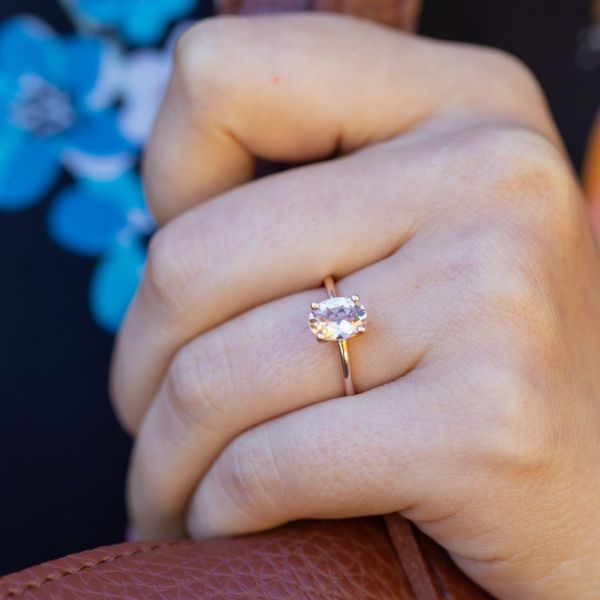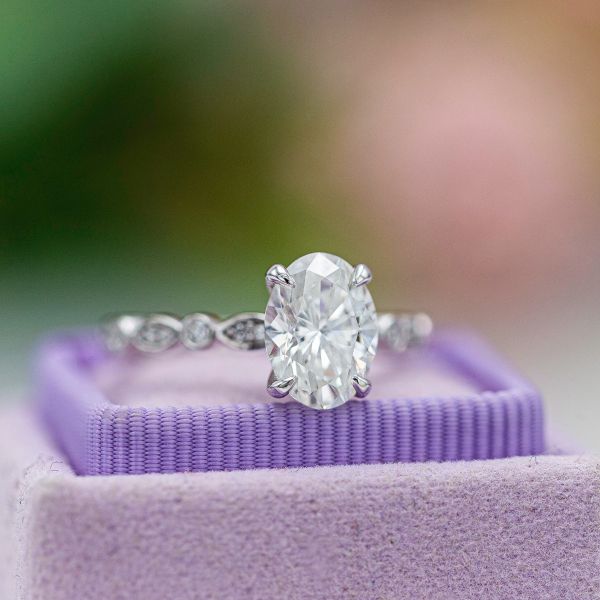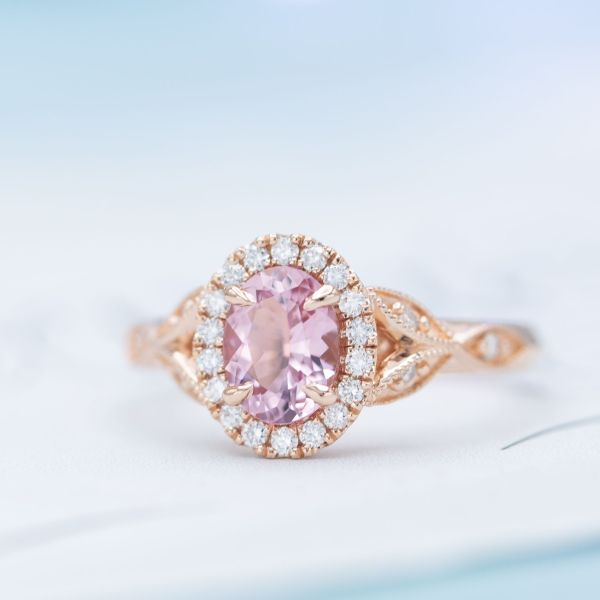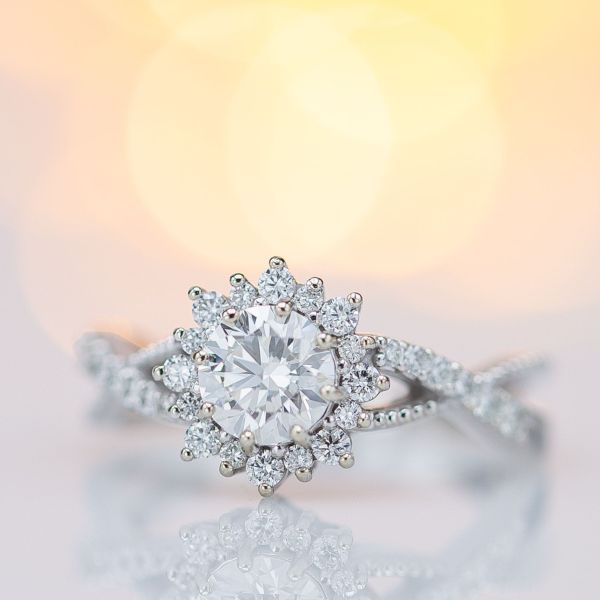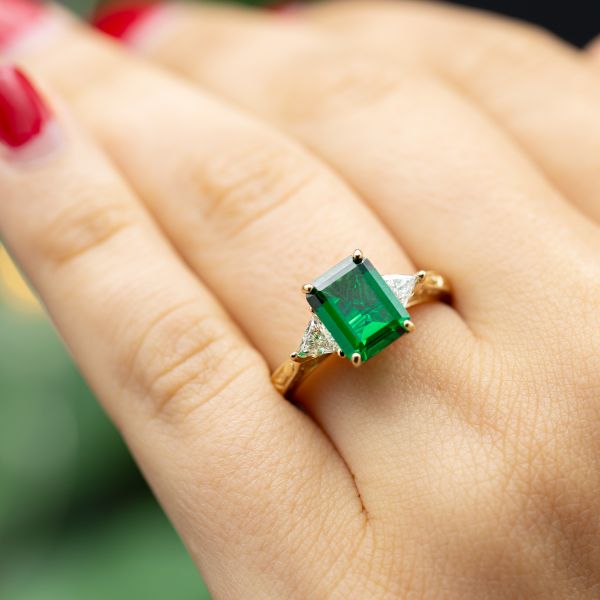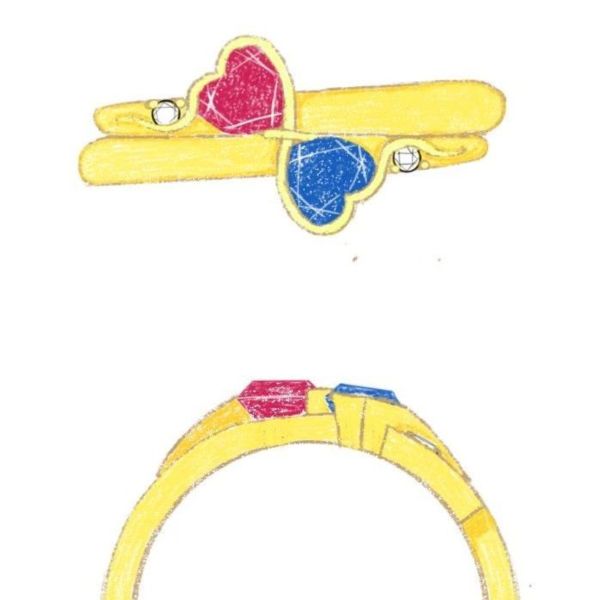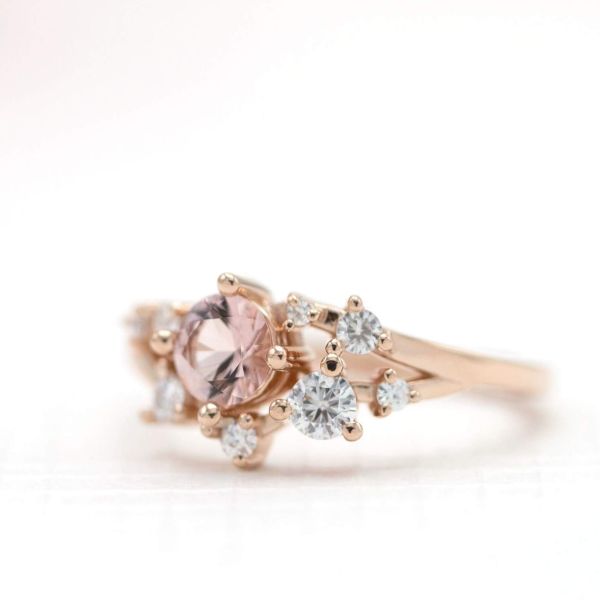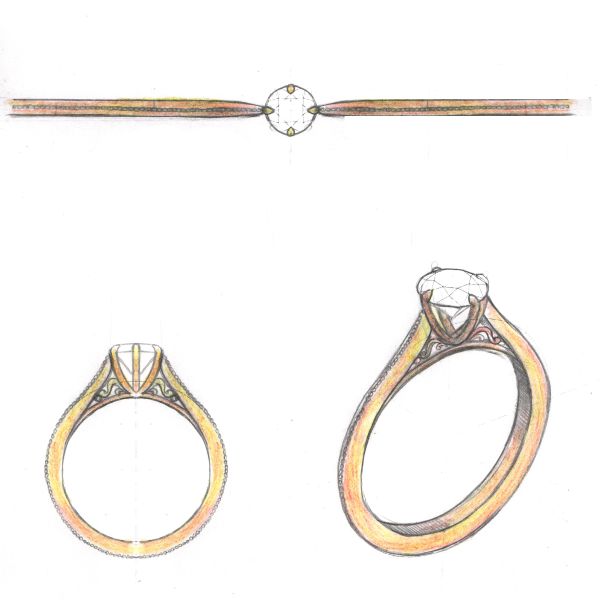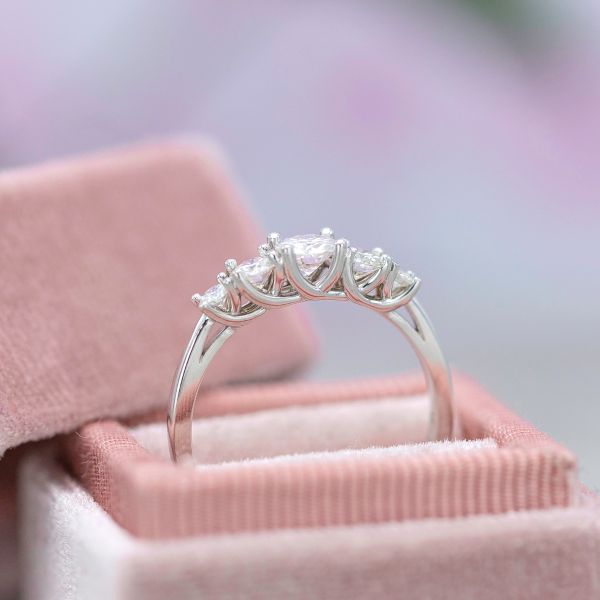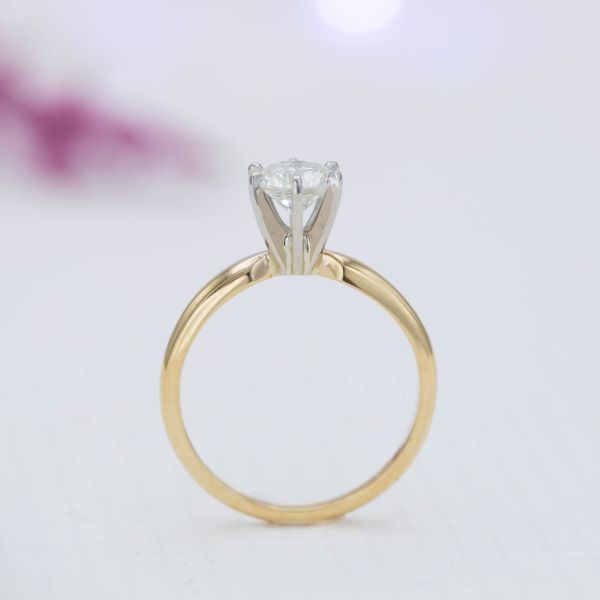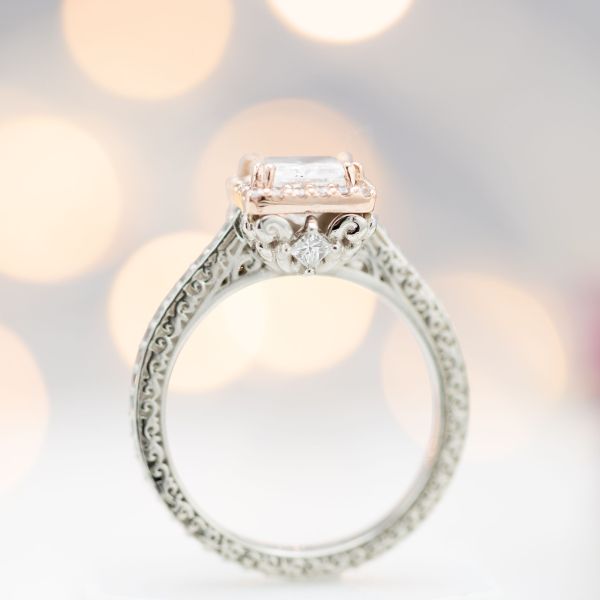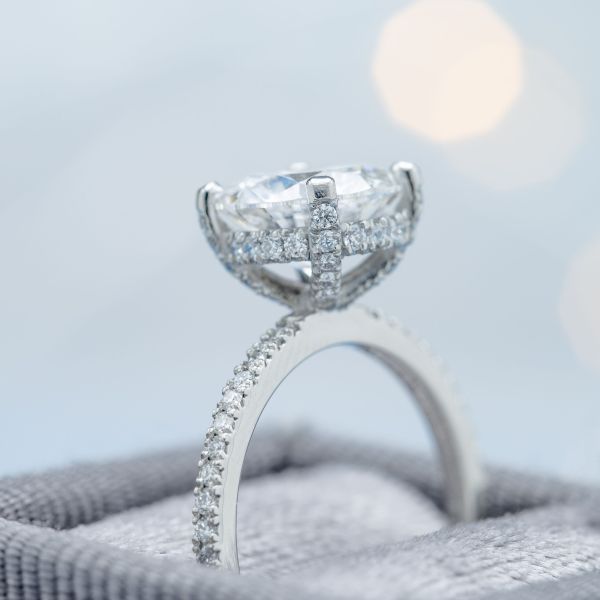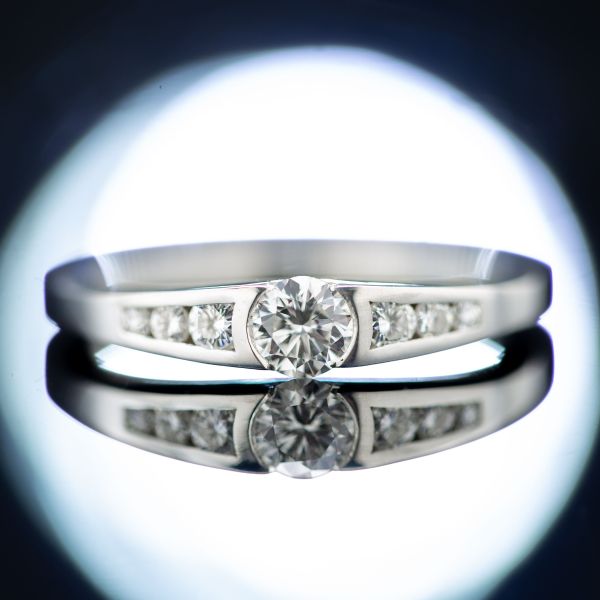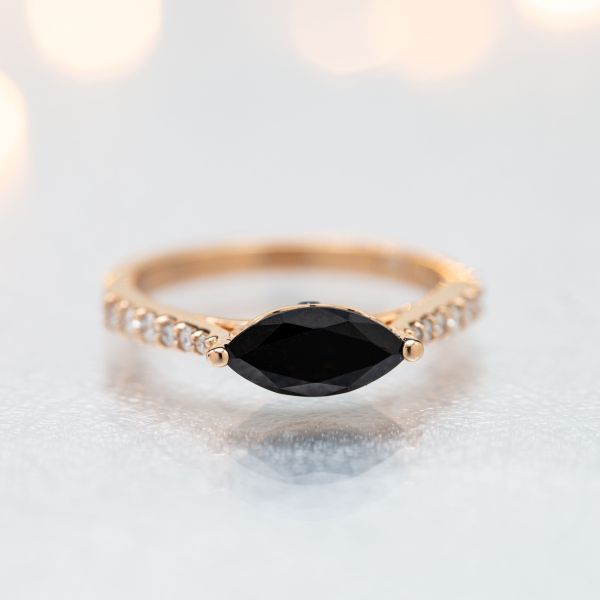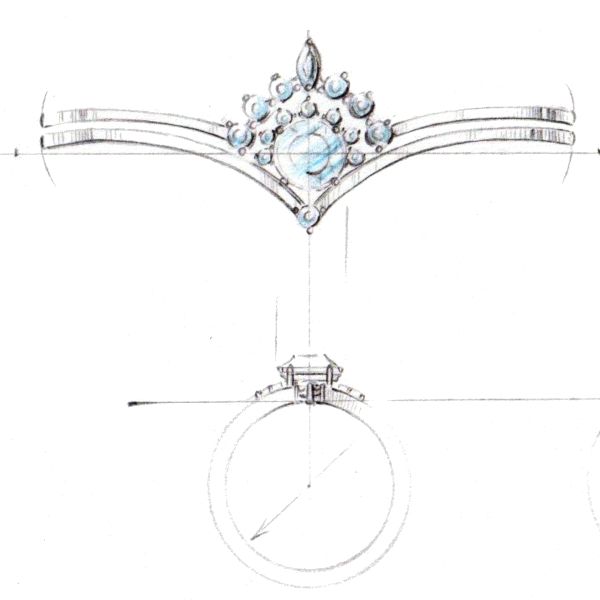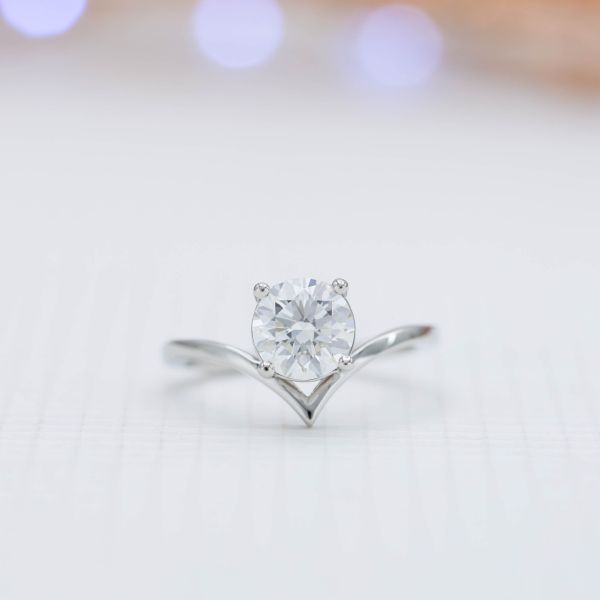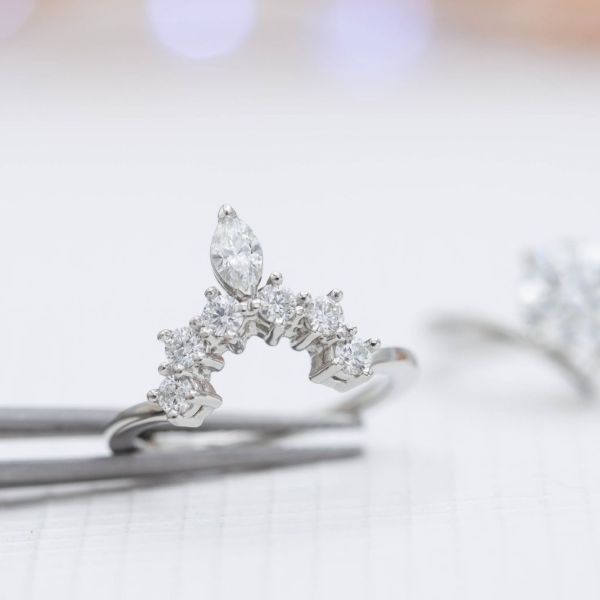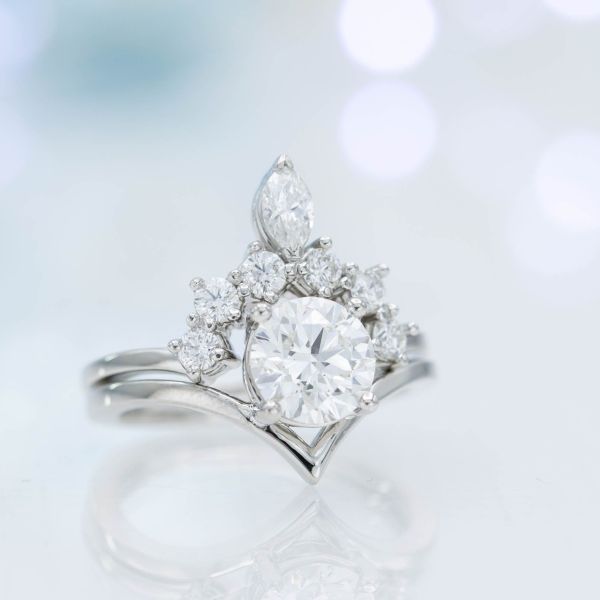Style Knowledge
Center Setting Styles for Engagement Rings
A comprehensive guide to engagement ring center settings and styles.
So you're ready to buy an engagement ring! How do you get started? Seems like an overwhelming number of choices — the shape and type of center stone, the metal color, an endless number of designs and styles. You should start by blocking off a few weeks to read articles like this one and get an intensive education in ring design, gemology, and jewelry styling. When you can properly identify milgrain and v-prongs and fishtail pavé, you're ready to start browsing through thousands of ring designs in stores and online catalogs. The perfect ring is out there! Probably. Just keep searching... and searching...
👀
No, wait. That sounds pretty awful. We really don't think you should have to be a jewelry expert to buy a ring, and we certainly don't think that browsing endless catalogs is a good way to find the right ring. We've built our entire business on the idea that you can partner with a team of specialists (our designers and gem experts and jewelers) to create the perfect ring. Our team provides the jewelry expertise, and you provide your knowledge of yourself and your partner and what's important to the two of you. We'll guide you through the important decisions as we create the perfect ring design together.
So if we don't think you need to be an expert, why create a guide to teach you about all these design details? Well, we know many of our customers like to do research as part of the experience. And it can be really helpful to learn a bit more about the design details we discuss along the way. So in this article, we’ll take you through some of the most significant design considerations for an engagement ring: the method of center stone setting, some common center setting styles, and a few popular side profiles. We’ll also discuss the ways durability, center stone shape, and the possibility of a matching wedding band can impact your design.
Feel free to read this top to bottom or skip around to read about specific styles and settings. And, as you're perusing the pictures, keep track of things you like or dislike. There's lots to love about every style, but some are surely much more right for you!
Five Methods to Set a Center Stone
First up: the center stone setting. The way we set the center stone impacts not only the overall style of the ring, but also its durability. We’ll start this off with the most popular methods, then discuss other options for unique aesthetics.
Prong Settings
By far the most common method of setting a center stone, prongs allow for lots of light, which means tons of sparkle! For round center stones, designs with four or six prongs are most common, but as few as three prongs could hold the center stone. Alternatively, using more prongs on a solitaire ring can give it a unique, vintage flair.
Of course, there are tradeoffs for the number of prongs that you use. While fewer prongs allow for more light on the center stone, they also make the stone a little less secure. For most lifestyles, a four-prong setting will hold the stone securely. If you have an active lifestyle or a larger center stone, six prongs are a great option for improved durability with plenty of light on your center stone.
Prongs on Different Gem Shapes
For gemstones with fancy shapes (which means anything but round) there are other considerations. We often recommend setting princess, pear, marquise, and heart shapes (i.e. shapes with "points") with protective corner prongs, to reduce the risk of the diamond or gemstone chipping at those most fragile spots. This can be as simple as setting the stone with a single prong on the corners or using an even more protective setting like a v-prong (a wider prong that hugs the corner, creating a shape like the letter 'v').
In addition, square or rectangular shapes usually look best with four prongs, unless you want to opt for a style with many prongs. For an octagonal shape like the emerald cut morganite pictured here, you may choose to design the prong setting to suit the shape. Here, we used paddle-style prongs that perfectly fit the corners of the octagon and accentuate its shape.
Prong Styles
Of course, prongs can come in a variety of shapes and sizes. Some prefer rounded edges, while others like the aesthetic of pointed or tapered prongs. And tapered prongs can offer a vintage feel when styled like claws or feel very modern by using sharper angles and straight lines.
Prongs can also be doubled up or tripled up to add even more variety to the possible looks. For example, we might use double-claw prongs to create a durable setting with a distinctly vintage feel. Or we might set triple prongs at the corner of a princess cut diamond to offer the protection of a v-prong with a distinctive appearance.
Bezel Settings
If prongs don’t fit your style, consider a bezel setting. This ancient method of setting a center stone actually results in a sleek, modern look. In a bezel setting, metal wraps around the gemstone entirely, leaving the stone very secure. Unlike prongs, it also won’t catch on clothing or gloves. That makes a bezel setting a great choice for someone with an active lifestyle or a hands-on job. It’s also an excellent option for soft center stones like opal or pearl, which can scratch easily in a prong setting. However, because bezel settings cover the edge of the stone, it will appear somewhat smaller. The stone will also receive less light, making it a little less sparkly.
Semi-Bezel
You could always compromise by designing a semi-bezel setting. Here, only part of the stone is bezel-set, leaving part of the setting open. This gives your ring a unique style and allows for more light to reach the stone, giving it more sparkle than a full bezel setting. Still, it does leave part of the stone exposed, where it could chip.
Tension Settings
Like prong settings, tension settings allow for a lot of light on your center stone. However, there are some drawbacks to a tension setting. In tension settings, the center stone is held in place by a great deal of pressure exerted by the metal, with the stone slotting into tiny, laser-cut grooves to keep it oriented the right way. If the ring is knocked hard, it’s possible that the stone will fall out. But that's true of a lot of settings — knock any ring hard enough and you might lose the center stone. For us, there are two bigger concerns:
- Few gemstones can survive a tension setting, since many types of gems would crack under the pressure. We don't want to limit your center stone choices, and we don't want any risk of breaking the perfect center stone during the setting process.
- Tension setting makes a ring impossible to resize, and that's a serious drawback for something you might buy for a partner with some risk that the size is slightly off, and for a ring they'll wear for the rest of their life. We prefer rings that can be easily adjusted if the ring size changes over time.
So we've chosen not to make true tension settings. Don't worry, there's a good alternative!
Opt for Tension-Style
Instead, you can get the same aesthetic by choosing a tension-style setting. To create this, we design a center setting with hidden support (e.g. a rail for the stone sits on) and create a setting more akin to a bar setting or a semi-bezel setting. For many faux-tension designs, we can create a look that, from most angles, looks just like a tension setting. With this type of setting, you’ll have a sleek and modern ring that you’re still able to re-size.
Bar Settings
One less common center stone setting is a bar setting. This type of setting employs vertical bars on either side of the stone to keep it in place. It provides a similar amount of light and protection as a semi-bezel and gives the ring a unique, geometric style. For a three-stone ring, these bars can also provide part of the support for the side stones, adding to the design.
Flush Settings
Flush settings are uncommon in modern engagement rings. In a flush setting, the gemstone fits into a hole drilled into the metal of the ring, and some of the metal around it is hammered over the edge of the stone. The stone is then flush with the surface of the ring, providing great protection against scratches. This setting is rarely used because it requires a small stone and a thick ring, the opposite of what most want in an engagement ring. Still, this setting is great for a unique, minimalist style. Flush settings are also a great option for side stones.
Creative Center Stone Settings
With a custom ring, you’re not limited to the classic methods. You could mix and match styles for an asymmetric look or have symbolic design elements in the setting.
If you’re looking for a touch of nature, consider a bezel setting that looks like a vine wrapped around your center stone. Or perhaps a ring with many prongs shaped like breaking waves encircling the center stone.
Center Setting Styles
There are endless possibilities for the center setting when you're designing a custom engagement ring. But there are a few common setting styles that are always popular, so it can help to get to know these common starting points. Do you like the prominent look of a center stone with little around it or the extra sparkle a halo can add? And when it comes to multi-stone settings, do you like symmetry or the beautiful chaos of asymmetric gem clusters? Take a look at these common setting styles and see what catches your eye!
Solitaire
For an engagement ring, solitaire styles are the most popular. As the name implies, a single stone takes center stage, with nothing to distract from its beauty. Simple solitaires fit a classic style, and are also great for minimalist rings.
Of course, you can still make a solitaire unique and personal. Decorative elements on the setting or band can add a personal touch. By using different prong shapes or adding hidden gems, the options for a solitaire are limitless.
In fact, solitaire rings don’t have to be simple at all. By using sculptural elements or unique side stones, you can create an intricate, vintage-style solitaire that’s anything but simple.
Halo
After the solitaire, halo settings are the next most popular choice for an engagement ring. In these styles, first popularized in the Victorian era, small diamonds or gemstones encircle the large center stone. Usually, halo settings employ small round stones, but some halos can use different shapes to create a unique effect. While most halos are a simple circle around the center stone, others are shaped to appear like flowers or a sunburst. Some rings even have multiple halos, sometimes employing two or more shapes or types of gemstones.
There are several advantages to choosing a halo style. The halo adds a lot of sparkle to the ring, and compared to choosing a larger center stone, a halo is much easier on the pocket. In addition, a halo of diamonds will actually make the center stone appear larger, when compared to a solitaire. If you’re looking for a sparkly style with a lot of finger coverage, diamond halo settings are a great option.
Three-Stone
If you need a lot of sparkle but a halo isn’t your style, consider a three-stone ring. These rings are just what they sound like, showing off three beautiful gems, and symbolize past, present, and future. Usually, the two stones on the side are smaller than the center stone. In this case, smaller side stones will make the center appear even larger. However, some prefer three-stone rings with each stone the same size.
While some choose three-stone rings with round diamonds or gems, others prefer to mix shapes. A round center stone with tapered baguettes was a popular style in the 1950’s and is seeing a resurgence in popularity. Side stones with trillion, pear, and marquise shapes also provide a tapered look to a three-stone ring. Stones with flat sides make great options for three-stone rings. Rings with three princess-cut stones give off tons of sparkle and show off the shape’s strong geometry. Personally, my favorite three-stone rings use three emerald-cut gems, enhancing the subtle hall of mirrors effect.
Two-Stone, Toi-Et-Moi
If you can’t choose just one stone, why not get two? Symbolizing the joining of two souls, two-stone settings are a romantic option for an engagement ring. These are often referred to as toi-et-moi settings, from the French for "you and me." While many choose a two-stone ring with two of the same gem, shape, and size, mixing and matching can result in a creative and unique ring. Ruby and sapphire combine for a colorful ring, while choosing a diamond and gemstone combination gives you a colorful pop with a lot of sparkle. Using gems with entirely different sizes opens up the design process to creative asymmetry.
Cluster
If you’d prefer several smaller stones to one or two larger ones, choose a cluster setting. In these settings, there may no single center stone, although one of the stones is often larger, anchoring the arrangement. Instead, many small stones grouped together imitate the appearance of a larger stone. Cluster settings are a great option for smaller budgets and those who prefer a low-profile ring that sits closer to the finger.
Cluster settings come in all shapes and sizes. Some rings feature a circular cluster, while others are squares or floral designs. Certain gemstone clusters appear like a colorful bouquet. With a well-balanced design, a colorful cluster setting can be a beautiful and unique way to celebrate your engagement.
Creative and Unique Options
Of course, you’re not limited to the typical center settings. There are plenty of creative ways to design an engagement ring.
Nature-inspired elements are popular in modern engagement rings. Some opt for gemstones arranged in a floral design, resembling their favorite flower.
Others use metal to create sculptural flowers, with petals unfolding around a small center stone. Sculpted elements can also create a tapered effect similar to a three-stone ring.
Still others opt for a large center stone, but hide the stone beneath open metal work. This gives a unique and subtle effect to the ring.
Of course, an engagement ring with a center stone isn’t everyone’s style. Five-stone and seven-stone rings featuring a row of sparkle across the finger have become popular. On the other hand, some minimalists prefer band-style engagement rings, with a row of small diamonds or gemstones. Or, if you’re not that into sparkle, you could create an engagement ring with cabochon gemstones or no gems at all! Remember, when it comes to your engagement ring, you make the rules.
Side Profile Styles
While the top-down view is what most people will see, you also need to consider what the ring looks like from the side. These details are like a secret, something most people won’t notice until you point it out to them. But, if you spend as much time typing as I do, you’ll see the side of the ring on a daily basis.
Cathedral
If you like ornate and sparkly, a cathedral setting might be just what you need. This type of setting lifts the center stone high above the finger, giving it more light. That means that it will have more sparkle and even look bigger.
From the side, you’ll see the circular band of the ring and metal structures that come up from the sides to support the center stone. These structures resemble flying buttresses, an architectural element found in the Notre Dame and other famous cathedrals (hence the name). This type of setting gives you a lot of space to personalize the side of your ring. Hidden gemstones and intricate metal work add interesting details to the side profile.
Of course, there is one major drawback to choosing a high-set center stone: it’s more susceptible to scratches and knocks. While this shouldn’t be an issue for diamond, moissanite, sapphire, or ruby, gems like emerald and opal face some issues with durability.
Trellis
In a trellis setting, the metal from the two sides of the band crosses over and comes up to form the center stone’s prongs. This small detail adds a lot to the side view of the ring, giving it gently flowing lines. While it looks great on solitaires, we can also modify trellis styles for three-stone rings, resulting in a beautiful pattern. If you’re looking for a subtle little detail, choosing a trellis over a martini style setting might be just what you need.
Of course, trellis settings can be combined with the cathedral’s flying buttresses for an intricate side profile. Embellishing the trellis with gems or filigree is another option to add details and sparkle to the ring.
Basket
In a basket setting, an open metal structure encircles the center stone's setting. Like the cathedral style, a basket setting can raise the gem higher, providing more light.
Again, this area provides an opportunity for personalization. Some encrust it with diamonds, while others place their favorite gemstone on the basket. Still, some prefer a simple design with plain metal. The aquamarine ring above balances the sleek, contemporary look of the ring with a touch of ornamental filigree on the basket, tucked around and under the large center stone.
Baskets can be combined with cathedral and trellis settings or used alone for a high-set solitaire.
Martini
In contrast, a martini style setting has a gem set in prongs without the basket encircling it, resembling a martini glass. This is similar to the famous Tiffany setting, and is great for a classic look.
Peek-a-Boo Settings
Whenever you’re looking at a ring from an odd angle and see a diamond or gemstone facing you, you’re looking at a peek-a-boo setting. So, any bit of sparkle on the side profile is in a peek-a-boo setting. There are plenty of ways to incorporate gems in a ring’s side profile, and these little gems often end up being people’s favorite part of the ring!
One popular method is setting a tiny gem below the center stone’s basket. In three-stone rings, of course, there’s the option for three tiny gems. Others prefer diamond-encrusted settings, like a falling-edge halo or encrusted cathedral, trellis, basket, or martini settings.
Peek-a-boo settings are also great for hiding a pop of color. Whether it’s your birth stone or just your favorite gem, hidden stones add a lot of personality to your engagement ring.
More Considerations for Center Stone Settings
Of course, we haven’t covered everything yet. Here are a few things to keep in mind when choosing your center stone setting.
Designing for an Active Lifestyle
If you have an active lifestyle, you’ll want an engagement ring to match. That means a center stone that’s secure in its setting and unlikely to chip or snag. Ideally, you’d choose a bezel-set center stone, since it’s the most protective setting. However, semi-bezels and bar settings make great choices, too.
If you’re worried about snagging, prongs aren’t a great idea. While well-set prongs shouldn’t snag, it is possible. Whenever a prong catches, it will loosen slightly, making your stone less secure over time.
It’s also important that the stone is set low and close to the finger. High-set stones are more prone to knocks and snags than a lower-set gem.
Many women simply choose to take off their rings whenever they're doing something hands-on, especially those who choose a more delicate center stone. Whether you’re comfortable taking off your ring is a personal decision, but if you are, it opens up your design possibilities.
Gemstone Shapes and Orientation
Opting for a fancy shape center stone? The way that you choose to orient a fancy shape diamond or gemstone says a lot about your style.
A lot of people are choosing East-West styles, where elongated shapes (oval, emerald, pear, marquise, and rectangular radiant and cushion-cuts) are set perpendicular to the length of your finger. Setting a gem like this makes the ring stand out, but it’s not for everyone. When oriented in the more traditional direction, elongated shapes make your finger seem longer and slimmer, something many people love.
In addition, squared shapes (princess, asscher, and square radiant and cushion-cuts) can be set either in the normal orientation or kite-set. Kite-set gems have a striking geometry and are sure to catch the eye, while square orientations have a more classic style. Have a look at this kite-set amethyst engagement ring:
For more asymmetric shapes, like pear, trillion, and non-standard shapes, you’ll have to choose how to wear the shape as well. For example, in a pear, do you want to wear the point toward you or away? Tradition says to wear the point toward you, but most modern styles have the tip pointed toward the fingernail.
Matching Wedding Bands
Finally, you should also consider how your engagement ring and wedding band should pair together. For certain settings, a straight wedding band will not sit flush against the engagement ring. If you want a straight band, you may need to choose a high-set gem.
Nowadays, many opt for a contoured wedding band to match their engagement ring. These bands will sit flush with the engagement ring and often add to the design. For example, a half-halo engagement ring paired with a half-halo wedding band will look like a full halo two-band ring, matching perfectly.
Of course, an intricate side profile is another reason to carefully choose a wedding band. Wedding bands often cover the lovely metal work and peek-a-boo gems that can make an engagement ring personal and special. We recommend that you consider designing the wedding band to match or to slot into the ring so you don’t miss out on the details. We often design the rings together even for customers who are not ready to buy both, to make sure the pairing gets some consideration early in the process.
About CustomMade
CustomMade designs and creates one-of-a-kind, custom engagement rings and fine jewelry. Each piece we create is inspired by you, designed for you, and made just for you.
